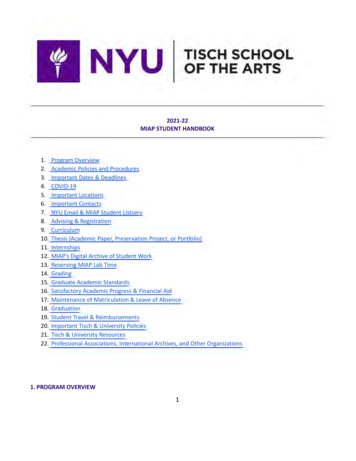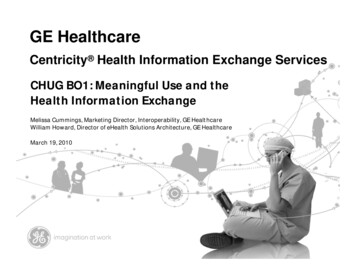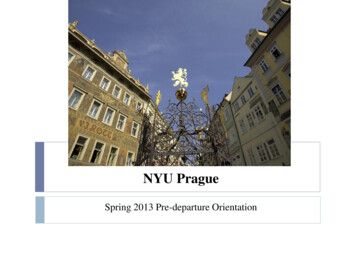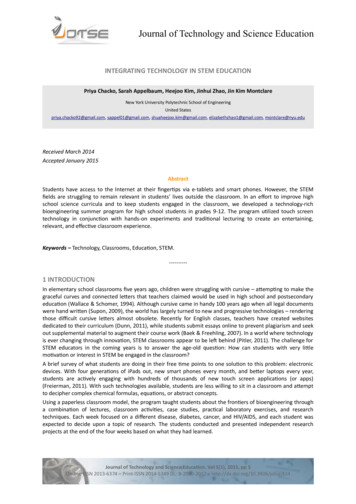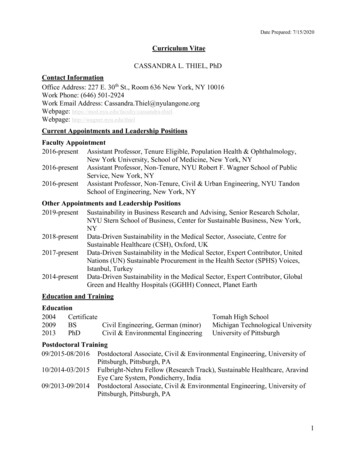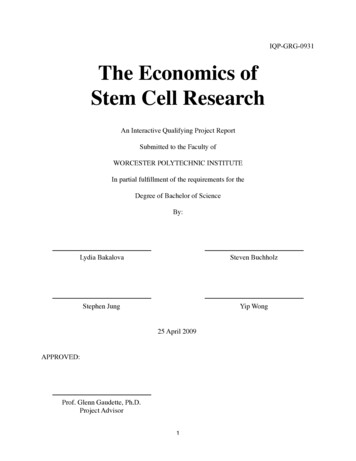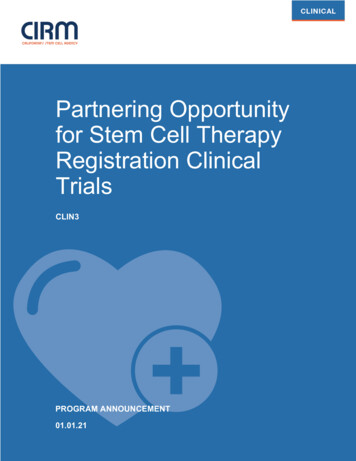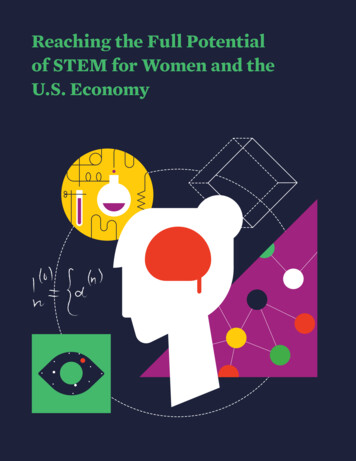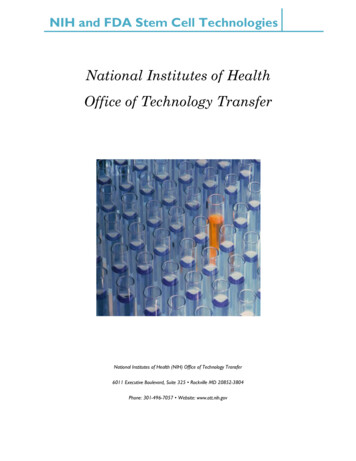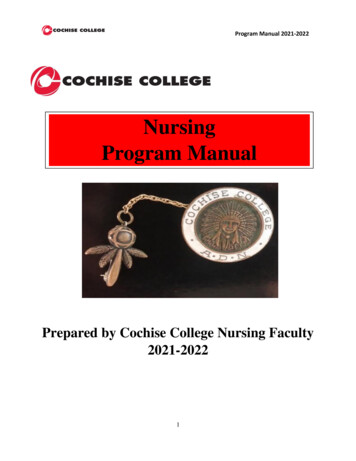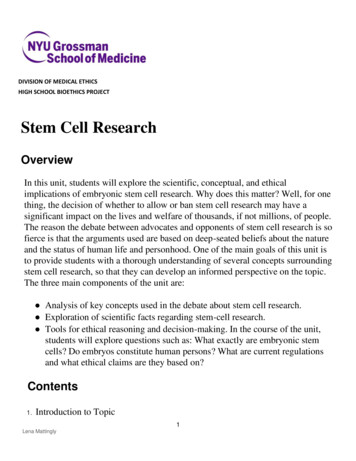
Transcription
DIVISION OF MEDICAL ETHICSHIGH SCHOOL BIOETHICS PROJECTStem Cell ResearchOverviewIn this unit, students will explore the scientific, conceptual, and ethicalimplications of embryonic stem cell research. Why does this matter? Well, for onething, the decision of whether to allow or ban stem cell research may have asignificant impact on the lives and welfare of thousands, if not millions, of people.The reason the debate between advocates and opponents of stem cell research is sofierce is that the arguments used are based on deep-seated beliefs about the natureand the status of human life and personhood. One of the main goals of this unit isto provide students with a thorough understanding of several concepts surroundingstem cell research, so that they can develop an informed perspective on the topic.The three main components of the unit are: Analysis of key concepts used in the debate about stem cell research. Exploration of scientific facts regarding stem-cell research. Tools for ethical reasoning and decision-making. In the course of the unit,students will explore questions such as: What exactly are embryonic stemcells? Do embryos constitute human persons? What are current regulationsand what ethical claims are they based on?Contents1.Introduction to Topic1Lena Mattingly
2.3.4.5.6.Pre-Existing KnowledgeThe Debate: Analysis of Key ConceptThe Facts: The Science of Stem Cells and Stem Cell ResearchEthical PerspectivesAdditional InformationLearning Outcomes1.2.3.4.Understand and assess the main arguments used in the stem cell debateLearn basic scientific facts about stem cells and stem cell researchUnderstand the ethical and philosophical implications of stem cellresearchDevelop and be able to defend a position on the issue of stem cell researchProcedures and ActivitiesThis unit uses a student-centered and interactive approach to teaching.Activities are designed to allow for a maximum degree of student participationand collaboration. Each activity is marked as an individual, partner, or groupactivity, or as a teacher-directed class discussion.The following are various types of activities: Individual ActivityPartner ActivityGroup ActivityTeacher-Directed Class Discussion1. Introduction to TopicThe current debate surrounding embryonic stem cell research dates back to 1998,the year Dr. James Thompson from the University of Wisconsin-Madisonsucceeded in isolating cells of early embryos (donated by individuals who wereundergoing treatment at fertility clinics), and developed the first embryonic cell2Lena Mattingly
lines. A heated moral debate ensued about whether the use of embryonic cell linesin research should be allowed or banned. This very public debate culminated withPresident Bush limiting federal funding of embryonic stem cell research to cellsthat had already been derived at the time of the announcement, on August 9, 2001.Despite Bush’s decision, the debate has since continued among scientists,bioethicists, religious leaders, patient advocates, celebrities, and politicians. On oneside of the debate, there are those who consider any kind of research on humanembryonic stem cells to be morally reprehensible, because it involves thedestruction of human embryos. On the other side, there are those who believe suchresearch to be crucial in the development of promising ways to combat otherwiseincurable diseases, such as Parkinson’s disease, or trauma such as spinal cordinjury. Early in his term, on March 9, 2009, President Barack Obama lifted the banon embryonic stem cell research. In 2019, President Donald Trump’sadministration ended all fetal tissue research, following a sustained campaign byabortion opponents, and then, in April 2021, administration of Joe Biden lifted theTrump ban.This unit consists of three main components: Conceptual Analysis: A close examination of key concepts used in the stemcell debate will give students an impression of how strongly people feel aboutthis issue, and introduce students to overarching questions for this unit:Should stem cell research be allowed or disallowed on ethical grounds? Thefollowing analysis of key concepts will raise questions about concepts like‘life,’ ‘personhood’ and ‘personal identity.’ Key questions include: What isthe definition of ‘life?’ When did you become you? Through independentexploration, students will become aware of the extent to which suchdefinitions are used in an ambiguous and misleading way, and that an indepth understanding of these notions is essential for decisions about thevalidity of the arguments that use them. Scientific Facts: Next, a brief presentation of the scientific facts about stemcell research will provide students with an understanding of the technicalterminology and distinctions between “stem cells” and “embryonic stem3Lena Mattingly
cells”, etc. What exactly are stem cells? What are embryonic stem cells?What does embryonic stem cell research entail? What are the potentialapplications and benefits of embryonic stem cells? Ethical Reasoning: armed with both an understanding of the key conceptsin this debate and an understanding of the scientific facts, students will beready to consider the ethical implications of this issue. Students will beprovided with the tools for ethical decision-making within the context ofthe major approaches to ethics, including deontological ethics,utilitarianism, and virtue ethics. Understanding these different ethicalframeworks will allow students to consider the moral complexity of stemcell research.2. Pre-Existing KnowledgeIndividual ActivityStudents will complete a questionnaire meant to tap into any pre-existingknowledge on the subject students may have. Students should answer as many ofthe following questions as possible: What are stem cells? Where do they come from? What do they do?What does research on stem cells entail?Why is stem cell research controversial?What celebrity is/has been advocating for stem cell research, and why?(Examples include: Christopher Reeve, Michael J. Fox, Nancy Reagan)Why do you think people may be opposed to stem cell research? Do you know anybody who is either involved in stem cell research, orcould profit from the results of stem cell research? Based on whatever information you may have about the topic: Are youa) more in favor, b) less in favor, or c) undecided on the question ofwhether stem cell research should be allowed? What is a key question you would like to explore with regard to thistopic?4Lena Mattingly
Collect and discuss students’ answers. Organize answers to question #8 on theboard.Questions may include: What exactly are stem cells? Are there different kinds? Whatare some goals or potential benefits of research on stem cells? Why is it controversial?On what basis should we make a decision? Is it legal now? Point out that all thesequestions will be answered in the course of this unit. Give a brief overview of theoverall structure of the unit.3. The Debate: Analysis of Key ConceptsIn this segment, students will be introduced to the debate over stem cell research. Byexamining statements made by people from different walks of life (politicians,scientists, religious leaders, etc.), students should get a sense of the key concepts usedin arguments on both sides of the debate. We offer 5 distinct activities that provide arange of teacher-directed discussions, partner projects, and individual activities toenhance students’ understanding of key concepts.Activity 1: Cartoon AnalysisTeacher-Directed Class DiscussionShare the following cartoon with students. What does this cartoon imply about thenature of the debate over stem cell research, and what seems to be the issue at theheart of this debate?5Lena Mattingly
Courtesy of Nick Anderson. Appeared originally in The Houston Chronicle 3/9/09.Activity 2: Quotation AnalysisPartner ActivityWith a partner, students will read the quotes below and answer the followingquestions:1) Which of the following statements support stem cell research? Which statementsoppose stem cell research?2) What are some key concepts used in these statements that may require furtherclarification, in order to fully understand and evaluate the position?Pope Benedict XVISept. 18, 2006, in an address to an international congress sponsored by the PontificalAcademy for Life and the International Federation of Catholic Medical Associations:“The destruction of human embryos to harvest stem cells is “not only devoid of thelight of God but is also devoid of humanity” and “does not truly serve humanity.”President George W. BushAug. 9, 2001, in an address to the nation on stem cell research:“An ethicist.told me that [a] cluster of cells is the same way you and I, and all therest of us, started our lives. One goes with a heavy heart if we use these [embryonicstem cells], he said, because we are dealing with the seeds of the next generation.”Chuck Colson, founder of Prison Fellowship MinistriesJuly 22, 2006, in an op-ed, “The Veto: Should We Cross the Great Moral Divide?”“The supporters of embryo-destructive research want to cross a great moral divide.They are seeking not only to destroy human life made in God’s image but also tomanufacture life made in man’s image. Tragically, we are losing this fight, however,because too few people understand the issues.”John Danforth, former U.S. senator and Episcopal priestNovember 2005, in a TV ad sponsored by the Missouri Coalition for Lifesaving Cures,advocating a state ballot initiative to allow stem cell research in Missouri:“My entire political career, I voted pro-life, and that is exactly why I favor the stem6Lena Mattingly
cell initiative. I believe in saving human life. I want cures to be found.”Bill Frist, former U.S. senator and Republican majority leader from TennesseeJuly 29, 2005, in a speech on the Senate floor: “I am pro-life. I believe human lifebegins at conception. I also believe that embryonic stem cell research should beencouraged and supported. An embryo is nascent human life. This position isconsistent with my faith. But, to me, it isn’t just a matter of faith. It’s a fact ofscience!”Orrin Hatch, former U.S. Senator from Utah July 23, 2006, commenting on PresidentBush’s veto of federal funding for stem cell research using human embryos on CBSNews Sunday Morning with Charles Osgood:“I understand that many have ethical and moral reservations about stem cellresearch, but for the same reason I describe myself as pro-life, I embrace embryonicstem cell research because I believe being pro-life is not only caring for the unbornbut also caring for the living.”And on NBC’s Meet the Press: “I just cannot equate a child living in the womb, withmoving toes and tigers and a beating heart, with a frozen embryo sitting in a labsomewhere.”Dr. Leon Kass, former chairman of the President’s Council on BioethicsOct. 8, 2004, in his Washington Post op-ed, “Playing Politics With the Sick:”“The moral issue does not disappear just because the embryos are very small orbecause they are no longer wanted for reproductive purposes: Because they areliving human embryos, destroying them is not a morally neutral act. Just as nosociety can afford to be callous to the needs of suffering humanity, none can afford tobe cavalier about how it treats nascent human life.”Kurt Warner, Arizona Cardinals quarterback and founder of First Things FirstFoundationOct. 27, 2006, in a TV ad in response to advertisements advocating stem cellresearch in Missouri: “I am all for finding a cure for any and every disease known toman, but there are certain issues that outweigh just finding a cure and doingresearch and life is one of those. As much as I’m for research, nothing outweighs thepro-life issue. [With embryonic stem cell research] you’re taking human life”7Lena Mattingly
J.C. Watts, former US Congressman from OklahomaAug. 12, 2001, in response to a question on whether he considers the president tobe“pro-life” on CNN Late Edition with Wolf Blitzer: “There’s just too many areasthat are inconclusive out there for us to get on a slippery slope to say we shouldtake life in order to enhance life”Laurie Zoloth, Ph.D., Professor of Medical Humanities & Bioethics and Religion,Director of Center for Bioethics, Northwestern University Sept. 29, 2004, in acongressional testimony to the Senate Subcommittee on Science, Technology andSpace:“While I respect that this is a difference in theology [regarding the moralstatus of a human child], and while I understand the passion and the conviction ofthose for whom the blastocyst is a person front the moment of fertilization, I do notbelieve this, and it is [a] matter of faith for me as well. My passion and myconviction are toward the suffering of the one I see in need, ill or wounded.”Colleen Parro, spokesperson for the Republican National Coalition for Life, June2001:“We do not believe that human beings should ever be sacrificed for the benefit ofanother. We thought we left that at Nuremberg more than fifty years ago.”Testimony of a disabled woman at a Congressional hearing: “Do I want to see again?Dance again? Hear like I once did? I do not want those things at the cost of any livingperson and I consider live embryos to be people.”Paul Berg, Cahill Professor of Biochemistry, Emeritus, Stanford University:“I am acutely aware of the ethical sensitivities that have been expressed regardingthe sources of stem cell lines. But, surely, obtaining cells from legally obtainedabortants or from early stage embryos that are destined to be discarded in the courseof IVF procedures and making them available for potentially life-saving purposeswould be viewed as ethically permissible if not a moral imperative?”Yvette Cooper, Junior Health Minister, UK Government, December 2000: “Inembryonic stem cells may lie the key to healing within the human body.”8Lena Mattingly
Christopher Reeve, Chairman of the Christopher Reeve Paralysis Foundation. Hesuffered a spinal cord injury in 1995, and died in October 2004. “Stem cell researchholds the promise of hope for 100 million people living with incurable diseases fromdiabetes to heart conditions to Alzheimer’s to Parkinson’s, ALS, MS, and spitted cordinjury. It will affect the entire American family. I believe this is why we find in this newsurvey such strong support from people with such diverse religious and ethicalbeliefs?”Collect and discuss students’ findings. (Answer to question #1: Support: Danforth,Frist, Hatch, Zoloth, Berg, Cooper, Reeve; Oppose:Pope, Bush, Colson, Kaas, Warner, Watts, Parro, disabled woman at hearing).With regard to the second question, concepts in need of further clarificationidentified by the students are likely to include: “life” and “human life.” In thefollowing activity, students will take a closer look at how these terms are used inthe above quotes.Activity 3: Clarifying ConceptsPartner ActivityWith your partner, look at the following statements and replace the underlinedwords with a synonym or a word/phrase that paraphrases its meaning. “I am pro-life” (e.g. for the protection of all forms of life, human life). “An embryo is nascent human life.” “[Embryos] are living human embryos.” “[We should not] take life in order to enhance life.”Collect and discuss students’ findings. It should be clear from the previous activity9Lena Mattingly
that the word “life” or its derivatives are ambiguously used in these statements. Itsmeaning ranges from “any kind of organic matter” to “a fully developed, livinghuman being.” In the following activity we will take a closer look at the meaning ofthe concept of life in general, and human life in particular.Activity 4: Classification of Living ThingsPartner ActivityIn this activity, students should organize a number of items according to thecategories: “alive,” “not alive,” or “not sure.” Students should compare their findingswith their partner and discuss what criteria they used to make their decision. Askstudents to come up with a definition of life that would cover all items listed in the“alive” category.Are the following: Alive, Not Alive, or Not Sure?VirusSesame seedRockHuman embryoIndividual spermHuman egg before fertilizationHuman skin cellRaindropFingernailTreeYeastPerson in a comaPerson in a persistent vegetative statePiece of woodYour computer10Lena Mattingly
Collect and discuss students’ findings. Based on their findings, students should try tocome up with a definition of life that they can all agree on.Students may refer here to one, or all of the “seven signs of life” (movement,respiration, sensitivity, growth, reproduction excretion, nutrition). Based on thisvery broad definition of life, students should then come up with a definition ofhuman life. What are the defining characteristics of human life that does not applyto all life, in general?Activity 5: Protection of Living ThingsPartner ActivityBased on our previous discussion, ask a partner: Which of the things that fall underour definition of life in general, and human life, are worthy of special protection?Do human beings deserve more special protection from harm or destruction thanother forms of life (e.g. plants, animals, etc.)? Why?Teacher-Directed Class DiscussionCollect and discuss results. Results may include: Non-human living things deserveprotection, only insofar as they are useful or important for us.Human beings, on the other hand, deserve protection because they are persons andas such have a special status. Therefore, any part of a human organism that isnecessary for its existence as a person (heart, brain, etc.) is protected fromdestruction, whereas parts that are not essential (e.g. fingernails, hair, etc.) are not.Further Questions for Discussion: How about limbs and other individual parts of the human body that are notessential to a person’s existence? Is this issue only a matter of life and death,or should human body parts also be protected from impairment? What are11Lena Mattingly
possible exceptions? Are there exceptions to the protection of persons? (Death penalty, war,self-defense, euthanasia, etc.) Who declares exceptions to this rule? On what criteria are these exceptionsbased? Is it possible for something to be a human being and not be a person? If so,does a human being that is no longer considered a person (e.g. a human beingin a permanent vegetative state) still fall under the moral idea that all lifeshould be protected? Could it be argued that all human beings (independent of their status as persons)and all parts of a human organism (independent of whether they are essential tothe survival of the person) should be protected from destruction just because theyconstitute a form of life (in the broad sense)?Let’s look at what we’ve come up with, so far: As we have discovered, the term“life” is used in the debate over stem cell research to mean a broad range of things:in the broadest sense, it is used to refer to all living organisms, whereas a narrowerdefinition of “life” refers to human life, and, more specifically, persons. While theremay be cases where we may no longer grant a person special protection (persons thatare seen as a threat to our society or country, or those who have committed heinouscrimes) or cases in which a living human organism is no longer considered a wholeperson (people in a permanent vegetative state), we could probably agree that, ingeneral, living human beings and all parts of the human organism are indispensableand their existence should be protected from destruction.Now, in order to better understand the debate over stem cell research, we need tounderstand what exactly stem cells are, and in what way the above stated principle,that life (qua human beings, persons) should be protected from destruction, may beviolated in stem cell research.4. The Facts: The Science of Stem Cell and Stem Cell ResearchTeacher-Directed Class Discussion12Lena Mattingly
What is a cell?Ask students to write down a definition. A cell is .Collect students’ findings. Answers may include: A cell is the smallest unit of aliving organism; basis of any living tissue; contains a nucleus, etc.Follow-Up Questions: How do you think stem cells are different from ordinary cells? What does the word “stem” suggest? Think of other uses of the word “stem” (e.g. stem of a tree, to stem from,etc.).Partner ActivityStudents will read the following text and answer the questions below.What are stem cells?Stem cells are undifferentiated or “blank slate” cells from which other types of cellscan develop. The defining characteristic of human stem cells is their ability for selfrenewal (produce an exact copy of themselves), while maintaining the potential todevelop into other types of cells, such as blood, brain or heart. Although all stem cellsshare these general characteristics, there are also significant differences among them.There are three major types of stem cells.Pluripotent stem cells (PS cells). Pluripotent stem cells have the capacity to divide forlong periods while retaining the ability to make all cell types within the organism. Thebest-known type of pluripotent cell is the embryonic stem cell. As the name implies,embryonic stem cells (or ES cells) are derived from embryos at what is known as theblastocyst stage of development. The stem cells originate from the inner cell massinside a hollow ball of cells that is smaller than the period at the end of this sentence.The unique characteristic of embryonic stem cells is the ability, in theory, to replicateindefinitely while retaining pluripotency. Understandably, such cells are crucial tobiomedical science as a potentially inexhaustible source of cells for both research13Lena Mattingly
applications and the potential ability to treat a multitude of different diseases.Fetal Stem Cells. These are derived from specific tissues of a developing human fetus.Scientists can generate cells from different regions of the developing body andcultivate them for long periods. These fetal stem cells seem to retain characteristics ofthe tissue from which they were taken. For example, fetal stem cells derived from thebrain have the capacity to make only nervous tissue, not blood or heart tissue.Sometimes these are called progenitor cells, indicating that they have the potential tomake only a limited range of tissue types.Adult Stem Cells. These can be isolated from some tissues of the adult body. Bonemarrow, for example, is a rich source of stem cells that can be used to treat some blooddiseases. Adult stem cells have been found in many different tissues, but they aresometimes limited in their ability to multiply in large numbers or differentiate into awide variety of cell types.Induced pluripotent stem cells (iPSCs). These are specially treated adult cells that canbe processed to behave somewhat like embryonic stem cells. This is a recentdevelopment that offers great promise. A Japanese research team in 2006 developedthe initial iPS process. In 2014, a different team in Japan found a much simplermethod. By exposing myriad adult cells to stress, they can be converted to stem cells.Successful stressors include a low pH (acidic) environment, a bacterial toxin thatperforates the cell membrane, and physical squeezing. Each method can convert thecells so that they show markers of pluripotency. In 2010, the Center for iPS CellResearch and Application (CiRA) at Kyoto University became the first centerdedicated to developing iPSCs for scientific and therapeutic applications.1. Howare stem cells different from regular cells?2. What does “pluripotent” mean, and how are pluripotent stem cells such asembryonic stem cells or iPSCs different from fetal stem cells and adult stem cells?3. What makes embryonic stem cells especially valuable for medical research andtreatment?4. What does the text say about how the different types of stem cells are generated?More information can be found here:14Lena Mattingly
.aspxTeacher-Directed Class DiscussionCollect and discuss students’ findings. Emphasize differences between adult andembryonic/fetal stem cells. Adult stem cells can be derived without harming ordestroying a human being. But because adult stems are already specialized, they canonly become the cell type present in the tissue from which they were taken.Embryonic stem cells, on the other hand, can turn into all of the 220 mature celltypes in the human body. However, in the process of harvesting embryonic stemcells, the embryos from which they are derived are destroyed. This issue is at thecenter of the stem cell debate. What is the status of the embryos that are used toharvest embryonic stem cells?Here are some more facts: Embryonic stem cells are typically derived from 3-6 day old human embryosThese embryos are usually leftover in vitro fertilization embryos, created in alaboratory dish for the purpose of treating infertilityUnused embryos are typically either donated to research, discarded, or frozenfor future useThe embryo at this stage is part of the blastocyst which consists of an inner cellmass (or embryoblast) and an outer cell layer (trophoblast) that laterdevelops into the placentaThe inner cell mass contains about 50 cells that have not yet developed intospecialized cellsCells derived from blastocysts are able to replicate themselves, i.e. they form‘cell lines’ that can be kept and used in research for a long period of timeEmbryonic stem cells are used to research the origins of many diseases (e.g.Parkinson’s, Huntington’s, Alzheimer’s, spinal muscular atrophy, etc.), areused to develop new drugs, and produce cells and tissues for transplants.Based on these additional facts about embryonic stem cells:15Lena Mattingly
How are these facts relevant to our discussion about “life” and “human life” inthe previous segment?What exactly is the status of an embryo that is used to derive embryonic stemcells?What kind of “life” is this? It’s considered a life (according to the broadestdefinition of life), but is it “human life”? And if so, does that make it a person?Where does the 3-6-day-old embryo fall on the line of human development,starting from the moment of conception and leading to the death of a humanbeing?In other words: When did you become you?Teacher-Directed Class DiscussionCollect and discuss students’ answers (e.g. the moment I was conceived, the moment Iwas born, the moment of my first memory, etc.) to the question: When did youbecome you?Discussion Questions:1.2.3.4.5.What do I mean, when I say, “I became me”?Does that mean that I was not myself in one moment, and in the next momentI was?If so, what are the criteria that would allow us to distinguish between the twostates?Does it make sense to say that the six-day-old embryo (that eventually turnedinto me) is as much myself as I am now? If so, in what sense?How is this related to our discussion of the difference between “human being”and “person”? (Does it make sense to ask: When did I become a person?)Since I am, as a human being (and especially a young human being), constantlydeveloping, maybe what I mean when I say, “The embryo is me”, is “The creationof the embryo is the moment at which the development that made me who I amnow, began. The embryo is potentially who I am now.”So, while we would probably say that the embryo constitutes human life and theearly stages of a human being, and thus a potential human being, does that mean16Lena Mattingly
that it should have the same protection as the actual person that it may become?Partner ActivityAsk students to think of other instances in which two objects are the same atdifferent stages of development (e g. acorn-oak tree, egg-chicken, manuscript-book,tadpole-frog, caterpillar-butterfly, etc.), and to decide whether the two should beconsidered the same thing, and in what sense.Discussion Questions:1.2.3.4.5.6.If I destroyed the acorn, did I also destroy the tree?Had I not destroyed the acorn, would it (necessarily) have turned into anoak tree?Is the tree that is being prevented from coming into existence by destroyingthe acorn a particular oak tree?How real is a potential oak tree?Is this comparison valid, or is there something different about human beings?What is the difference?Is there a difference between the acorn I destroyed and other acorns that arekept in storage, but are never used (and thus never allowed to develop intooak trees)?All these questions lead us now to the question of whether it is ethical or not todestroy embryos to generate stem cells.5. Ethical PerspectivesAs we have seen, one of the key questions in this debate is that of the status of theembryos that are used to develop stem cell lines. Is it unethical to destroy embryos thathave the potential to turn into human persons? Should human persons be protectedfrom destruction at all costs? (Let's also consider other cases in which we allow for thedestruction of human persons—war, death penalty, lack of money available for safetyand health care, etc.) And even if we deem embryos potential persons worthy of17Lena Mattingly
special protection, to what extent does the preservation of potential persons outweighthe impact of stem cell research on future individuals?Group ActivityDivide students into small groups. Each group will read one of the following texts,reflecting on a particular philosophical approach to making ethical decisions. Askeach group to consider whether a proponent of their approach would consider stemcell research ethical or unethical.Deontological EthicsAdvocates of Deontological Ethics believe that certain actions are right or wrong inthemselves, regardless of what consequences they may have. such actions areforbidden or required by the dictates of reason.The most influential philosopher to espouse this view—and, arguably, the mostimportant European philosopher of all time—was Immanuel Kant (1724-1804).Kant argued that the highest good, the only thing that is good without qua
The Facts: The Science of Stem Cells and Stem Cell Research 5. Ethical Perspectives 6. Additional Information Learning Outcomes 1. Understand and assess the main arguments used in the stem cell debate 2. Learn basic scientific facts about stem cells and stem cell research 3. Understand the ethical and philosophical implications of stem cell .
